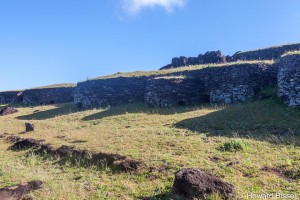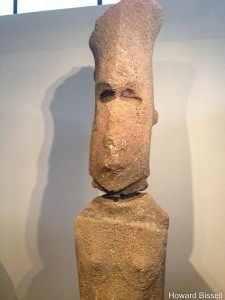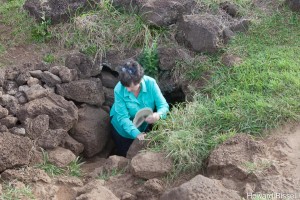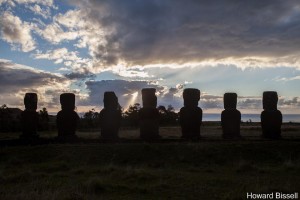The party last night lasted until after 4am–and we were NOT invited! I wake up grouchy with NO hot water. It goes without saying that I do not take a shower.
Orongo and the volcano crater, Rano Kua, is our morning destination. Orongo was not a permanent village but a site for various ceremonies, celebrations and coming-of-age rituals for young boys and girls. The location on the side of the crater is incredible but it lacked a fresh water source and the proximity to the ocean for fishing. Towards the end of the 17th century the tribal structure of the island was breaking down and the warrior class was gaining prominence. The warrior class’s goal was to undermine status and rank and reward physical prowess. Toward that end the Birdman Competition was started.
Each spring when the Sooty Terns returned to the small offshore islands to lay their eggs, competitors from the island’s tribes would make their way up the mountain to Orongo. They would install themselves in the grass-covered stone houses that are standing today due to restoration in 1974. The competitors would then prepare themselves for the month-long Birdman ritual. To start the ritual, the men would scale the cliffs down to the ocean, swim about 1.5 miles to a small island and wait for the first eggs to be laid. The first man to find an egg and swim back with it intact was the winner of the competition. His tribe would be revered and benefit from increased access to food and water for the coming year. The last race took place in 1866 after which the Catholic missionaries put an end to the event.
The competitors would then prepare themselves for the month-long Birdman ritual. To start the ritual, the men would scale the cliffs down to the ocean, swim about 1.5 miles to a small island and wait for the first eggs to be laid. The first man to find an egg and swim back with it intact was the winner of the competition. His tribe would be revered and benefit from increased access to food and water for the coming year. The last race took place in 1866 after which the Catholic missionaries put an end to the event.
Unfortunately early western visitors to the island stole the beautiful painted stone slabs that adorned these houses. There was also an incredible Moai with carvings associated with fertility and the Birdman competition that was pilfered in 1868 and is now at the British Museum in London. The village site also contains incredible petroglyphs that unfortunately are not accessible today due to the fragile nature of the ruins.
Our next destination is the island museum, the home of over 15,000 island artifacts (although not all are on display). It is incredible! There are lots of informational panels telling the history of the island. There is one female stone figure that looks like an alien–I guess that’s where some of those “outer-space” stories came from. We see the only Moai “eye” that has survived. It’s white coral with a red volcanic iris. There are reproductions of the Rongo Rongo tablets, wooden boards that legend says were brought to the island by the first king, Hotu Matu’a, from his homeland. The writing system employed is called reverse boustrophedon meaning one line in one direction and the next line in the opposite direction but upside down. The board must be turned round and round to be read. It is surmised that the tablets contain information on island culture and tribe history but unfortunately no one has been able to decipher the writings.
We see the only Moai “eye” that has survived. It’s white coral with a red volcanic iris. There are reproductions of the Rongo Rongo tablets, wooden boards that legend says were brought to the island by the first king, Hotu Matu’a, from his homeland. The writing system employed is called reverse boustrophedon meaning one line in one direction and the next line in the opposite direction but upside down. The board must be turned round and round to be read. It is surmised that the tablets contain information on island culture and tribe history but unfortunately no one has been able to decipher the writings.
We drive up the coast a little way to Hanga Kio’e. This site has a single restored Moai and also has some nice ruins of a village. It’s considered to be of the most recent period of Moais construction.
It’s time for lunch! Rex is keen on trying a local dive (and I mean DIVE). We have sandwiches and fries and it’s not bad at all. (Although I can think of several other great places I’d go to before I come here again.) While we’re waiting on our food, a small child, encouraged by his mother, hands us each a different local magazine. The articles amazed each of us! There was one article on arson on the island that was particularly alarming–islanders taking out their unhappiness with neighbors by burning their homes. It certainly gave us a different perspective of the life here.
We hunt for Hotel Antiplanico here on the island (the same hotel group where we stayed in San Pedro). We are not impressed. It’s too remote; you would need a car. As much I might criticize our current hotel it IS in a perfect location.
We take the coast route further north. It is a VERY rough road–that’s an understatement!! We see Motu Tautara, a small island off the coast. Nearby the Ana Kakenga cave is actually a lava tube. It must be quite long because is inland a bit but has an outlet on the ocean. Rex and I go to entrance but without a flashlight we are not inclined to go further.
As we continue up the coast we arrive at Ahu Tepeu, a very isolated, unrestored platform with lots of archaeological vestiges. This was at one time a large village. There are ruins of many, large boat houses (so-called because they would have looked like an overturned boat); chicken houses (rock enclosures); and stone circles in which agricultural items were planted. There are 5 fallen Moais plus at least one or two completely broken Moais. This ruin is unusual in that not only were the Moais destroyed but the platform was too.
We head back to Aha Akivi for late afternoon photos. Rex breaks out the beer for our return trip. We arrive back in Hanga Roa for sunset photos at Ana Kai Tangata. Across the way is the elegant Hanga Roa Hotel. We enjoy Pisco Sours on the terrace before heading back home.
Across the way is the elegant Hanga Roa Hotel. We enjoy Pisco Sours on the terrace before heading back home.
